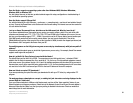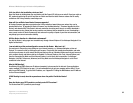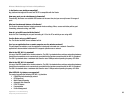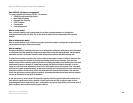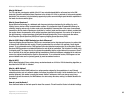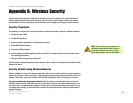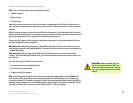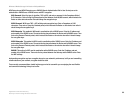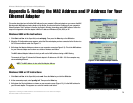
69
Appendix B: Wireless Security
Security Threats Facing Wireless Networks
Wireless-G Media Storage Link Router with SpeedBooster
WPA Enterprise and WPA2 Enterprise use a RADIUS (Remote Authentication Dial-In User Service) server for
authentication. RADIUS uses a RADIUS server and WEP encryption.
WPA Personal. Select the type of algorithm, TKIP or AES, and enter a password in the Passphrase field of
8-63 characters. Enter a Group Key Renewal period time between 0 and 99,999 seconds, which instructs the
Router or other device how often it should change the encryption keys.
WPA2 Personal. WPA2 uses TKIP + AES, with dynamic encryption keys. Enter a Passphrase of 8-63
characters. Then enter a Group Key Renewal period, which instructs the Router or other device how often it
should change the encryption keys.
WPA Enterprise. This method is WPA used in coordination with a RADIUS server. Enter the IP address and
port number of the RADIUS server. Then enter the key shared between the Router and its RADIUS server. Then
enter a Key Renewal Timeout period, which instructs the Router or other device how often it should change
the encryption keys.
WPA2 Enterprise. This method is WPA2 used in coordination with a RADIUS server. Enter the IP address and
port number of the RADIUS server. Then enter the key shared between the Router and its RADIUS server. Then
enter a Key Renewal Timeout period, which instructs the Router or other device how often it should change
the encryption keys.
RADIUS. This method is WEP used in coordination with a RADIUS server. Enter the IP address and port
number of the RADIUS server. Then enter the key shared between the Gateway and its RADIUS server. Enter
the WEP settings.
Implementing encryption may have a negative impact on your network’s performance, but if you are transmitting
sensitive data over your network, encryption should be used.
These security recommendations should help keep your mind at ease while you are enjoying the most flexible
and convenient technology Linksys has to offer.



